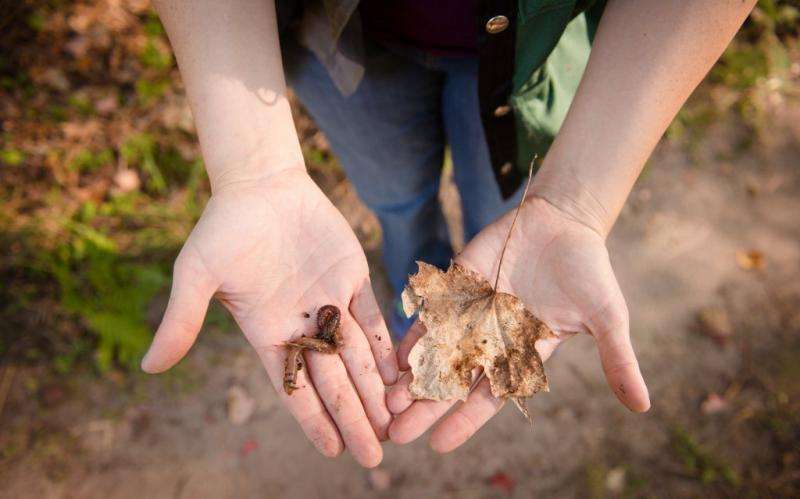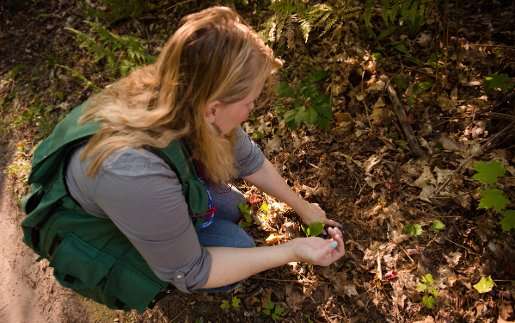Invasive earthworms at the root of sugar maple decline

A new study suggests that non-native worms are eating up the forest floor, causing sugar maples to die back and perhaps harming other forest dwellers.
The worms crawl in, the worms crawl out, and corpses aren't the only casualties. A Michigan Technological University scientist has fingered non-native earthworms as a primary culprit in the decline of an iconic American tree.
An industry at risk
Sugar maples are prized as much for their valuable lumber as for their sugary sap and dazzling fall colors. In Michigan alone, they are the basis of a multi-million-dollar industry. But several years ago, foresters began noticing that the crowns of the big trees appeared unhealthy, with bare limbs and little new growth.
"They were losing trees before they could harvest them," said Tara Bal, a research assistant professor of forest resources and environmental science. "We wondered what was causing it." Her findings were published July 26, 2017, in the journal Biological Invasions.
Drought was a suspect—the traditionally damp northern Great Lakes region was in the midst of a dry spell. Other potential causes were forest management practices, soil types, climate change and the mix of species in the area.
From 2009 to 2012, Bal made annual visits to more than 100 sites in Michigan's Upper Peninsula, northern Wisconsin and Minnesota. She found one factor that stood out: the condition of the forest floor. And nothing affects a forest floor quite like earthworms.
While they may seem as American as maple syrup, no earthworms—including the nightcrawler—are native to the Upper Midwest. If there ever were any, the last ice age wiped them out over 11,000 years ago. "All the earthworm species here are from Europe or Asia, brought in when humans transplanted plants," Bal said. Now, they and their egg cases hitch rides on tires and muddy boots and spread when anglers dump bait in woods and waterways. "It's the same way invasive plants get around," she said.
Voracious invaders
Before worms invade, the soil in a typical northern forest is blanketed by a thick layer of leaf litter and other organic material. When worms arrive, they quickly gobble it up and expose bare dirt. "And earthworms really like sugar maple leaves," Ball said. "They are sugary, soft, and have fewer tannins than other trees, like oaks."
Sugar maples have a particular characteristic that makes them even more vulnerable to earthworms. Ninety percent of their roots are in the top few inches of soil, so the trees rely on the litter to keep the soil from drying out. With the litter gone, maples can slowly die of thirst.

While the condition of the forest floor appears to be driving the maples' dieback, there could be other factors as well, Bal said. "At this point, we don't really know if earthworms are causing damage directly or making the soil and litter conditions so poor that drought and other things are getting to the trees."
Collateral damage: birds, bugs and more
Maples aren't the only victims of these wriggly invaders. Many other forest creatures depend on forest litter for their survival. "I was just looking at the health of the trees, but earthworms are really affecting the whole forest," Bal said. "You lose wildflowers, young seedlings and many ferns." The worms can reduce ground-nesting birds, insects, amphibians and fungi whose lives are intertwined with the forest litter. "I've never seen a salamander on the Michigan Tech Trails, but I've seen a lot of nightcrawlers," she noted.
People can slow their spread by throwing bait in the trash and washing mud off vehicles and boots before traveling into the woods. "If you are a forest manager, you should power-wash your equipment when you go from one place to another and use local road fill as much as possible," Bal said. "That's a good practice for stopping the spread of all exotic species, not just worms."
It's highly unlikely that the earthworms will go away, however. "Predictions are that within 100 years, 95 percent of our sugar maple forests will be invaded by earthworms, and there's no worm-icide."
Fewer maples, more diversity
"This means change for the forest," said Bal. "Forest managers will have to start thinking outside the box to keep forests and trees healthy and regenerating."
That could mean a return to diversity; sugar maples did not always dominate northern hardwood forests. "We have pure maple stands because it's a valuable wood," she said. "If some of the sugar maple dies back, you could have the return of other species, like basswood, birches and ironwood.
"That could make the forest more resilient," she suggested. "The way things stand now, if something that loves sugar maple, like the Asian longhorn beetle, ever got here, we could lose our hardwood timber industry."
The study was conducted in the Hiawatha, Ottawa, Superior and Chequamegon-Nicolet National Forests; Baraga State Forest; and commercial forestland owned by the Boston-based investment firm GMO.
The article on the study, "Evidence of Damage from Exotic Invasive Earthworm Activity Was Highly Correlated to Sugar Maple Dieback in the Upper Great Lakes Region," was published July 26, 2017, in the journal Biological Invasions.
More information: Tara L. Bal et al. Evidence of damage from exotic invasive earthworm activity was highly correlated to sugar maple dieback in the Upper Great Lakes region, Biological Invasions (2017). DOI: 10.1007/s10530-017-1523-0
Journal information: Biological Invasions
Provided by Michigan Technological University



















